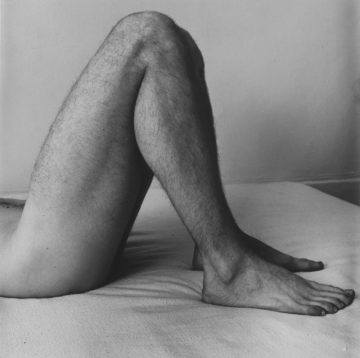Joanna Cresswell in Lens Culture:
 “How to describe the effect of these photographs?” writes Moyra Davey on the pictures that the late American artist Peter Hujar took of the Hudson River in 1976. “The water seems embodied, we see faces—eyes and lips—and liquid takes on a velvety smoothness and viscosity that could almost be a solid. Each image seems to have its own personality, and we sense Hujar’s presence as well, a man standing on a pier, with all the connotations of that locale, looking out and taking in the river at his feet. I wonder if he knew when he took the pictures that the resulting images would be so sensual, so corporeal and unearthly at the same time.” Davey writes these words at the end of The Shabbiness of Beauty, a newly published photobook, in which she delves into the image-archives of Hujar and edits his photographs into a new series together with her own.
“How to describe the effect of these photographs?” writes Moyra Davey on the pictures that the late American artist Peter Hujar took of the Hudson River in 1976. “The water seems embodied, we see faces—eyes and lips—and liquid takes on a velvety smoothness and viscosity that could almost be a solid. Each image seems to have its own personality, and we sense Hujar’s presence as well, a man standing on a pier, with all the connotations of that locale, looking out and taking in the river at his feet. I wonder if he knew when he took the pictures that the resulting images would be so sensual, so corporeal and unearthly at the same time.” Davey writes these words at the end of The Shabbiness of Beauty, a newly published photobook, in which she delves into the image-archives of Hujar and edits his photographs into a new series together with her own.
Davey has worked in two ways in this book—as photographer, and as curator of both her own and someone else’s vision. A someone she cannot talk with, since Hujar’s life was tragically cut short by an AIDS-related illness in 1987. What is most fascinating about this is how she works in the same way in both roles, moving intuitively—emotionally, even—through pictures by her own hand and by Hujar’s. You cannot tell which picture belongs to which artist until the index at the end, and even then it’s difficult to work out without going all the way back through and counting, because there are no page numbers either. In this way, and in many others, this is a book that requires time. It asks you to look again and again, and to see the images as one collection—to understand that the separate visions of two people are entwined here momentarily.
The Shabbiness of Beauty also has a third voice; that of poet and writer Eileen Myles, who opens the book with a text. Leaping back and forth between memories and decades, drawing from the present—with references to the pandemic—as well as the recent past and stuff that happened forever go, Myles pins Davey and Hujar’s images to personal associations, and to things that were happening during the time the writer spent with these pictures.
More here.
